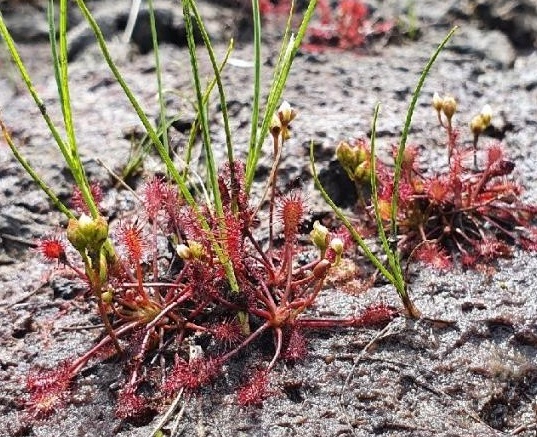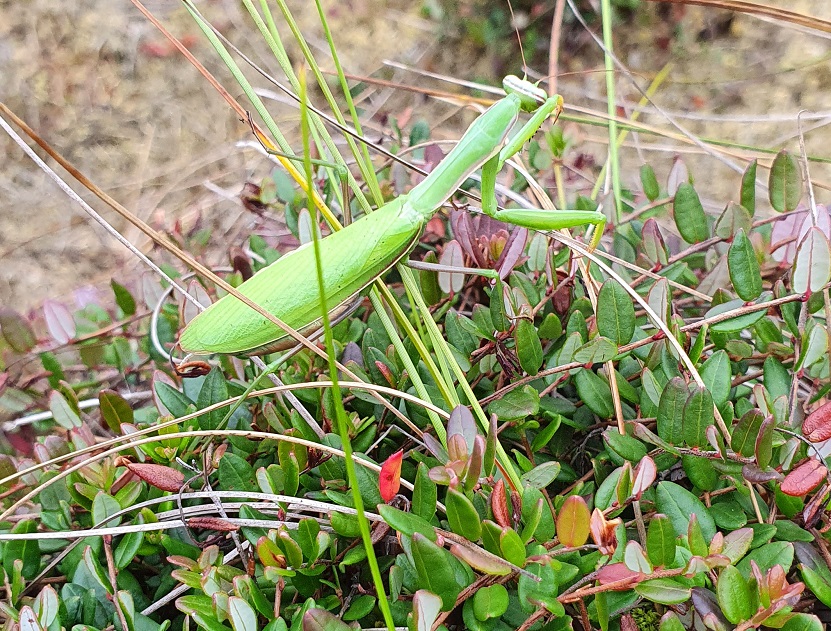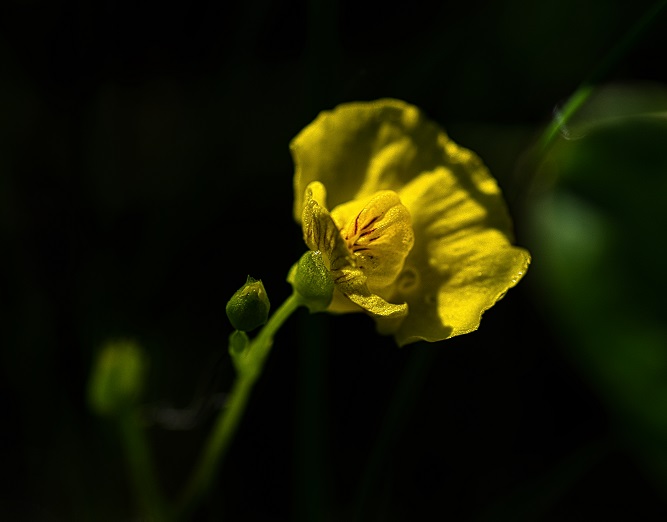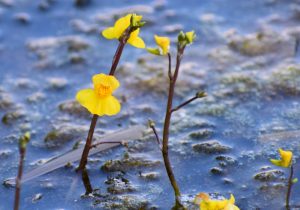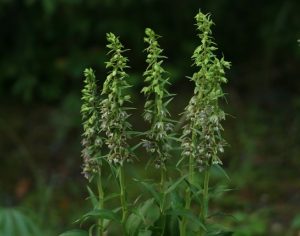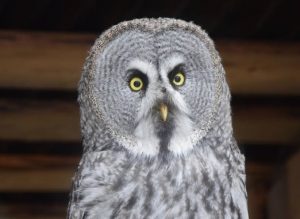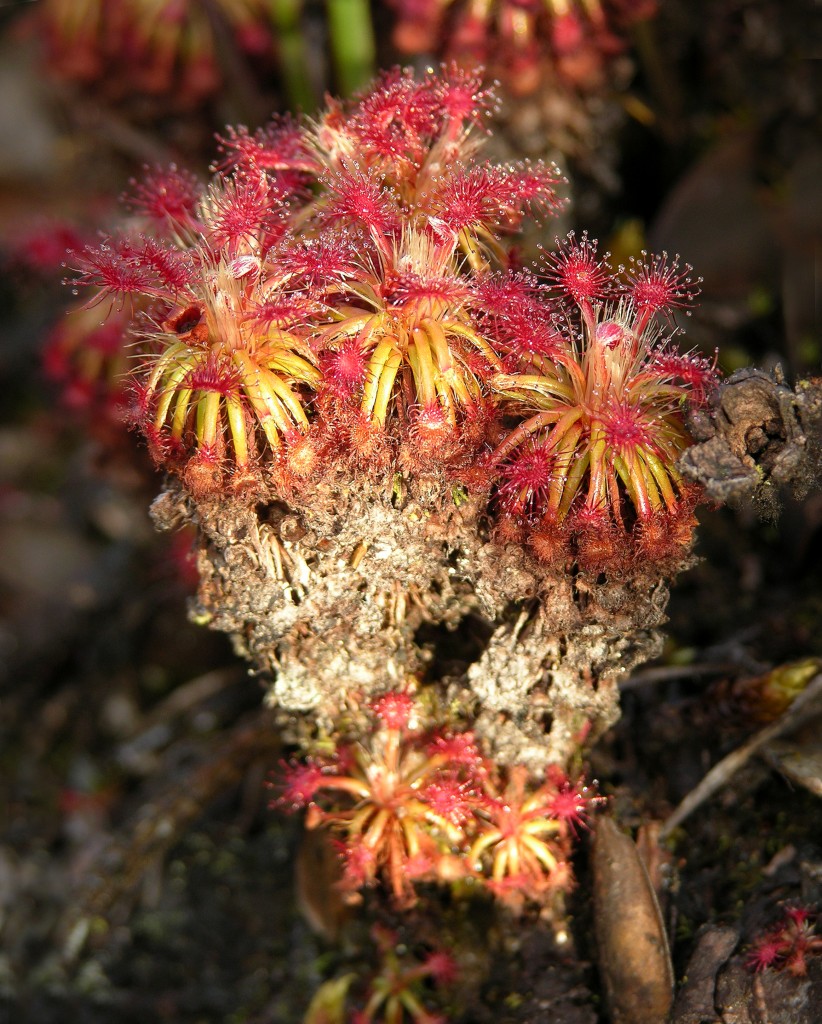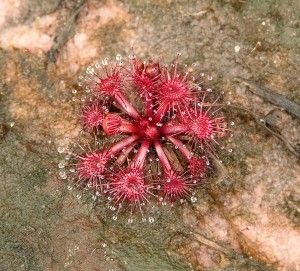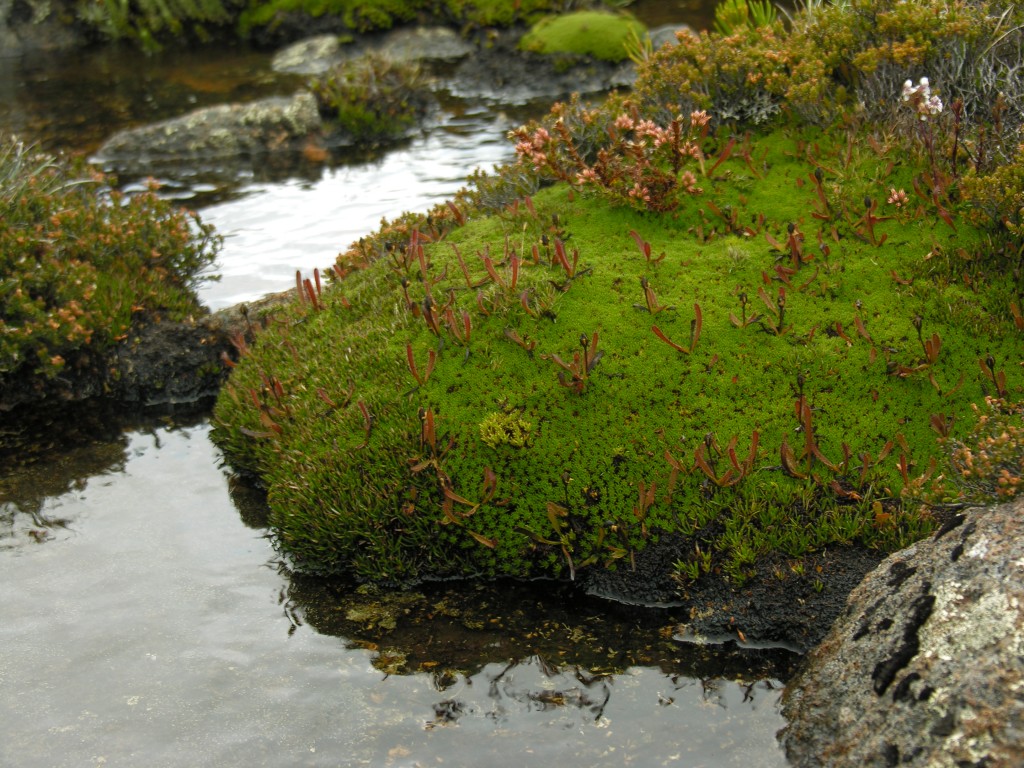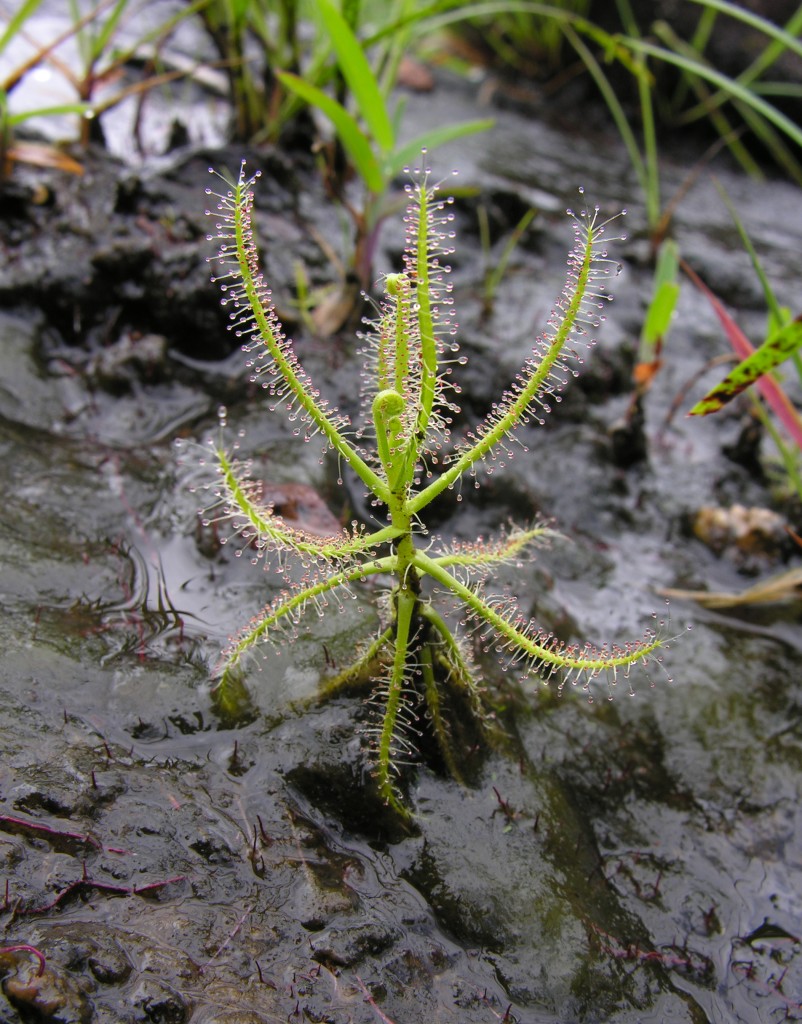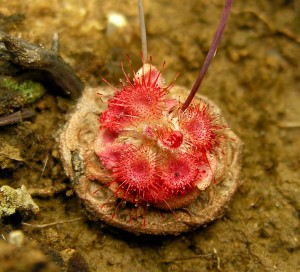Drosera is the largest and most diverse genus of all the sticky insect eating plants – that is to say, the seven genera of plants which trap arthropods (mainly insects) by secretions of glue that like the plants sticky leaves. Currently, 188 species have been found, with representatives on every continent except Antarctica and in almost all countries of the world. The genus was named by Carolus Linnaeus in 1753, the name Drosera is derived from the Greek drosos (dew) and refers to glistening appearance of the plants’ glue laden leaves which sparkle and glisten in sunlight much like dew at dawn. Indeed, it is also the sparkling, appearance of the plants’ leaves which give this group their English name ‘Sundew’.
Among the Drosera we see remarkable diversity in terms of morphology and colouration. Drosera are perennial or annual plants and produce leaves of varying shapes and sizes that are lined with highly complex stalked glands that secrete droplets of sticky water based mucus. At least two species, (D. arcturi and D. caduca) also produces small nonglandular (noncarnivorous) leaves too. The structure of the foliage of Drosera varies greatly, while many species produce small compact leaves arranged tightly in rosettes, others produce foliage that is more loosely arranged along an erect, often branched climbing or scrambling stem. While the lamina is often circular or oval in shape, in some exceptional species it is highly divided or linear and extremely elongated. The leaves of Drosera range between 0.5 cm – 100 cm, the very largest foliage is produced by members of the D. binata complex which can be borne on extremely elongated petioles. The smallest Drosera are minute rosetted species which can be as little as 1 cm in diameter whereas the very largest are climbing and scrambling species which can form stems up excess of 3 m in length.
Sessile glands (on the surface of the lamina) and stalked glands (tentacles) can clearly be distinguished on the leaves of Drosera, the glue that is secreted by the stalked glands of Drosera species is extremely ropey and forms thin threads and is therefore extremely efficient in trapping insect prey. In most species, the stalked glands are capable of movement, although to highly variable degrees and additionally, the leaves of some (although certainly not all) species of Drosera can twist and curl to ensure prey is overwhelmed and digested. This ability of the plant’s foliage to respond by moving ensures that prey is caught efficiently and unable to escape and that digestion also takes place as efficiently as possible since the surface area of the leave in contact with the trapped prey is maximized.
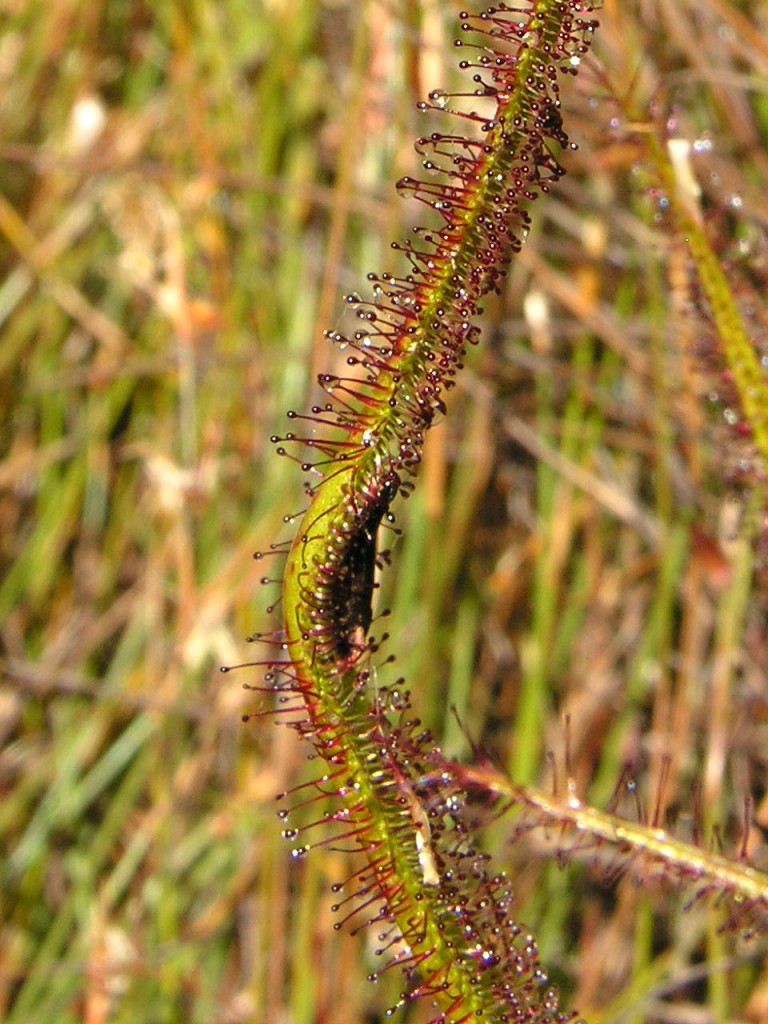
The leaf of the rare D. regia that has caught a beetle. This species occurs in only one valley in South Africa
The sundews of the world can be divided into six groups:
The largest group of Drosera consists of the fifty five currently recognized species of tropical perennial Drosera which are found throughout South East Asia, Australiasia, Africa, and the Americas. Most species of Drosera found in Indonesia are representatives of this group. All of the tropical perennial Drosera grow continually throughout the year, without any period of dormancy or rest.
The second largest group of Drosera comprises the forty eight currently recognized species of tuberous Drosera which occur exclusively in Australia except for one species which occurs widely across South East Asia. The tuberous Drosera are so called for their ability to produced an underground tuber which enables they to become dormant during the hot and (in Australia) often extremely dry summer months.
The third largest group of Drosera consists of the forty eight species of minute pygmy Drosera which are found in Australia and New Zealand. The pygmy Drosera are extremely small, and mature specimens of many species are less than 2 cm in total size. Many are highly localized and occurring in small geographic ranges, in some cases, restricted to just a few square kilometers. The pygmy Drosera mostly have an annual growth cycle that incorporates a period of dormancy or semi-dormancy.
The forth largest group of Drosera includes the twenty eight species of temperate perennial Drosera known mainly from North America, Europe, North Asia and the extreme south of South America and Australia. The temperate perennial Drosera all become dormant during the cold winters of their habitats and temporarily die down to a dormant resting bud.
The fifth largest group of Drosera is the eight species of annual Drosera several of which are found in Indonesia. The annual Drosera all grow from seed, flower, set seed and they die within 12 months, usually during the wet season. This dynamic ecology has enabled most of the annual Drosera to become very dynamic and populate wide areas of the globe, including much of South East Asia.
Lastly the smallest group of Drosera consists of the seven species of South African summer dormant Drosera which form thick, fleshy roots which enable survival during periods of drought and hardship. This group occurs exclusively in South Africa and has evolved in parallel to the tuberous Drosera.
The total number of Drosera known around the world is increasing continually. Owing to the often remote nature of the habitat of species of Drosera, new species are found on a regular basis and several are described each year. In 2005, without any expectation, I was fortunate to encounter a localized population of a new species of Drosera in South America which has recently been named D. solaris. In view of the discoveries of the 20th century, it is now clear however, that Australia is the overwhelming center of diversity for this genus, being home to over 100 species in total.
Several Drosera are found across Indonesia, of which, D. indica and D. burmannii are among the most common. D. indica is a spectacular annual species which produce an upright or scrambling stem which supports linear leaves up to 12 cm in length. The leaves of D. indica can be yellowish green, orange or red and are lined with copious quantities of sparkling droplets of glue. D. burmannii in contrast, is a small, rosetted species, which forms a flat circular rosette of leaves that are up to two centimeters in length and are usually yellowish green, and lined with red tentacles. The sticky tentacles of D. burmannii can bend especially fast, and can reflect 180 degrees in less than two minutes, making it one of the fastest moving species of Drosera. Both species are common in Sulawesi.
With their beautiful, glistening foliage, the sticky insect eating plants are fascinating to grow and study at home and many can be cultivated very easily. All Drosera except the Tuberous and South African fibrous rooted species, require permanently moist or wet substrate, high humidity and bright light in order to grow healthily. In most cases, Drosera grow best in an equal mix of sphagnum moss peat and silver sand and benefit from being grown in a pot stood in permanently standing water positioned in direct sunlight. In such conditions, many Drosera will grow vigorously on windowsills, in bog gardens, in greenhouses and terrariums with excellent results. I recommend the reader to the works of D’Amato (1998), Slack (1979, 1986) and Rice (2006) as these works provide excellent information on growing the most commonly encountered sticky insect eating plants in cultivation.
The conservation status of the 188 currently recognized species of Drosera varies profoundly. In some cases, plants such as D. rotundifolia, D. intermedia and D. anglica are so widely distributed and populous that despite the scale of habitat destruction that has taken place, the total wild populations of these species still remains so extensive and widespread that there is no real risk of global extinction. In other cases, such that of D. solaris and D. regia in which the total known wild population occurs in a very small area, the risk of extinction is much more real and could easily be caused by a single catastrophic event. Indeed, in the case of D. regia, the entire wild population that is known to exist is found only in seepage fed, wet, boggy areas of one small valley in the Bains Kloof Range in South Africa and the total known wild population of this plant consists of just a few hundred individuals spread between two small populations each occurring across an area of just a few hundred m². A single catastrophic natural event, such as an extreme, prolonged drought, or one caused by man, such as the artificial draining of the habitat of D. regia could rapidly exterminate the entire wild population of this species very easily. Fortunately the habitat of this plant is relatively remote and so far, no species of Drosera has become extinct or is known to be imminently endangered and long may it remain so.
Various species of Drosera can be purchased from the following sources:
Hewitt-Cooper Carnivorous Plants (a specialist nursery that focuses on Drosera)
The Homestead, Glastonbury Road, West Pennard, Somerset, BA6 8NN, United Kingdom
Website: www.hccarnivorousplants.co.uk
Hampshire Carnivorous Plants
Ya Mayla, Allington Lane, West End, Southampton, SO30 3HQ, United Kingdom
Website: www.hantsflytrap.com
P&J Carnivorous Plants
The Hayden, Brampton Lane, Madley, Hereford, HR2 9LX, United Kingdom
Website: www.pj-plants.co.uk
Sarracenia Nurseries
37 Stanley Park Road, Carshalton, Surrey, SM5 3HT, United Kingdom
Website: www.sarracenia.co.uk
Shropshire Sarracenias
5 Field Close, Malinslee, Telford, Shropshire, TF4 2EH, United Kingdom
Website: www.carnivorousplants.uk.com
Bibliography
- D’Amato, P. 1998. The Savage Garden: Cultivating Carnivorous Plants. Berkeley, CA: Ten Speed Press.
- Rice, B., 2006 Growing Carnivorous Plants Portland, OR: Timber Press.
- Slack, A. 1979. Carnivorous Plants. London, England: Ebury Press.
- Slack, A. 1986. Insect Eating Plants and How to Grow Them. London, England: Alpha Books.
Stewart McPherson
